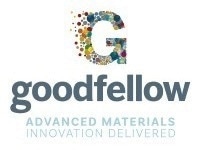In this interview, Dr. Aphrodite Tomou, Technical Manager at Goodfellow, talks to AZoM and explains why Goodfellow materials were selected for a space mission.
Recently, platinum wires supplied by Goodfellow were used to create a sensor that measured thermal conductivity and thermal diffusivity that was onboard a spacecraft developed by NASA which shuttled towards the surface of Saturn. Why was Goodfellow’s platinum wires selected for this mission?
Goodfellow is very fortunate to provide materials of high standards to NASA. We have collaborated with NASA for many years, and we had always provided them with the best materials, so that was one of the reasons why NASA trusted us with the job.
Goodfellow supplied platinum wire to NASA for this mission. Supplying this material to these researchers was a very big contribution for us because we fabricated the guidelines for the Ring Imaging Cherenkov Counter system which was employed into the international space station.
Shuttling towards Saturn’s moon using Goodfellow Materials
What qualities and features could the space mission expect from the platinum wires?
Goodfellow is well known for its high purity materials and technical support that assist at every step of every experiment or research idea. Therefore, Goodfellow was selected to be NASA’s preferred platinum wire supplier. For this mission, they expected consistency in the purity of the wire and the mechanical properties.
We ensured this consistency by continuously characterizing the mechanical properties and chemical analysis of every single batch. If there was even a slight problem, then we replaced the batch. The mechanical properties were consistently monitored by a special heat treatment that we performed on the platinum wires. This was very important for the application and we were very thorough, performing every single analysis so that the final material met the mission’s requirements.
What benefits can important missions and research projects like this expect from using Goodfellow’s range of materials compared to other providers on the market?
At Goodfellow, we have an excessive selection of materials and a technical team who fully support our customers. Our team consists of many researchers with a wide range of knowledge and expertise in different areas.
For example, we have experts in polymers, metals, alloys, ceramics, nanomaterials, and all kinds of commodities. Goodfellow can also supply materials or products in very small quantities.
This is very important for the researchers because they can buy cost-effective materials and determine whether it fits their experiment. Then the researchers can change the material and switch it out for another option, providing them with the opportunity to find out which material is most suitable for their application.

Image Credit:Shutterstock/Dima Zel
The purity of alloys is extremely important as it could comprise the whole aerospace project. How can Goodfellow help overcome challenges like this?
For aerospace and such demanding applications, the alloy production process you follow is very important. Goodfellow can produce custom made alloys including custom combinations of dissimilar metals or combinations that do not exist in the market.
For example, we can produce alloys containing platinum, silver, copper, and aluminum in different atomic or weight percentage combinations. The customer comes to us with their specific requirements for an alloy and we might be able to provide this.
We have different production methods. One method is vacuum arc melting, and another is mechanical alloying a process similar to metal powder processing. We usually use the vacuum arc melting process for demanding applications, especially aerospace, as it provides homogeneous and high purity alloys. The homogeneous ingot that this process produces can be ground further to achieve the particle size requirements of the customer.

Image Credit:Shutterstock/NASA images
Why should an aerospace/aviation company choose Goodfellow as its materials provider? How does Goodfellow compare to other material providers?
Our comprehensive range of materials can be used for practically every part of the aircraft, even for the engine. Goodfellow is a one-stop shop for the aerospace and aviation industry. For example, we have metal alloys like aluminum alloys and titanium alloys, as well as polymer and composite materials that can be used on the body and engine of the aircraft.
Around 80% of aircraft are made of composite materials. Our range includes composites that can be used on the aircraft body, as well as single crystals that can be used in the blades of the engine. In addition, Goodfellow supplies environmentally friendly graphene, a material that can reliably be used in various aviation components whilst enhancing environmental awareness and sustainability for the future.
About Dr. Aphrodite Tomou
Aphrodite is the Technical Manager of Goodfellow Cambridge Ltd, a leading global supplier of materials for research, innovation and development in science and industry sectors. Goodfellow has an extensive range of products, which are monitored and enhanced by Aphrodite and her team. Aphrodite has a diverse background and wide-ranging knowledge of materials, from nanomaterials to metals, ceramics and glass.
She holds a PhD and Masters in materials science and engineering, has published several papers in peer-reviewed international journals, and presented at international conferences as an invited speaker. Her team consists of scientists and engineers having expertise in various material areas and processes. Together, Aphrodite and the Technical team assist researchers and engineers, on a day-to-day basis, in finding solutions to even the most challenging of research problems.
About Goodfellow

Goodfellow supplies metals, ceramics and other materials to meet the research, development and specialist production requirements of science and industry worldwide.
The Goodfellow group consists of four companies. The main administration, research laboratories and workshops are located at the Company's headquarters in Cambridge, England. The subsidiary offices in America, France and Germany provide an additional service.
Disclaimer: The views expressed here are those of the interviewee and do not necessarily represent the views of AZoM.com Limited (T/A) AZoNetwork, the owner and operator of this website. This disclaimer forms part of the Terms and Conditions of use of this website.